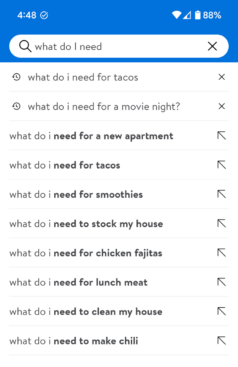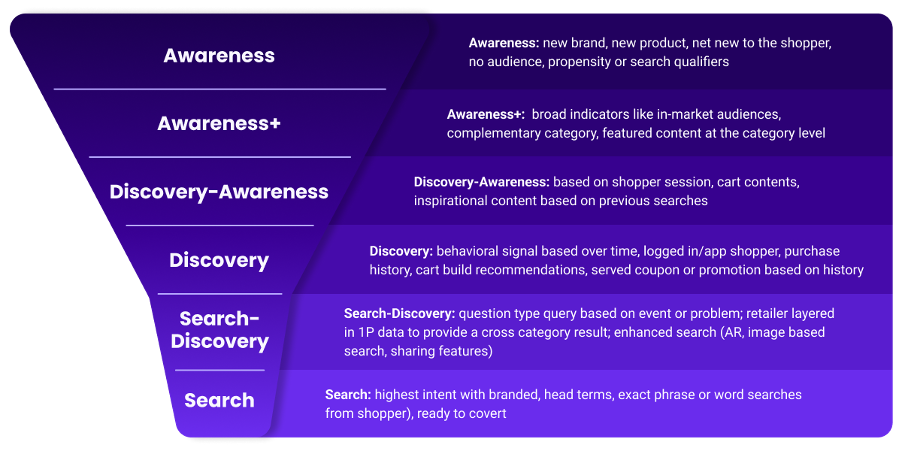Retail Media Search Is Where Intent and Discovery Will Merge
Introducing the Adweek Podcast Network. Access infinite inspiration in your pocket on everything from career advice and creativity to metaverse marketing and more. Browse all podcasts.
Digital marketers are moving up the funnel—we’re going in-store, the cookies are crumbling—and still, the humble place where it all started, search, is not only surviving but thriving.
You might think sponsored search ad revenues of Amazon, the giant of retail media, would have slowed down by now. But nope. The market is predicting another double-digit year of growth for them. Other, younger retail platforms like Walmart, Instacart and Kroger still have a lot of room to grow—in part due to consumers increasingly using their platforms for categories that have not historically been online, especially in food, beverage and personal care.
For any retailer today, including Amazon, sponsored search advertising includes several ad types like sponsored products, videos, ads and brands. The evolution we’re seeing has retail sites branching out not just in category but also in variations of search.


Yes, search is still relevant, but that’s not the headline. The story is how it’s evolving and where it’s headed, and the answer is up—as in up the funnel. Search from here forward will enable retailers and brands to overlap into discovery like never before, thanks to retail media. This is about raising the bar on search to a place outside what we normally expect; consumer expectations are accelerating fast, and search as we know it, everywhere, must innovate along with it.
Where retail media search is headed
Think about the kinds of searches you (and your customers) used to do just 10 years ago and where you did them. Now consider what’s happening today—not just with Gen Z, but with Gen Alpha (aged 13 and under), who is growing up with “connected everything,” who “reads” in video and does it at a volume and speed that obliterates the memory of dial-up internet connections.
These young consumers have already started to make their mark on the world: If you have kids, how much influence do they have on your shopping selection compared to what you may have had yourself as a kid? I bet you heard a lot of “no.” Today, thanks to some research from Paramount, we know that nine in 10 household purchases across categories are influenced by Gen Alpha, who also now represent 15% of the total U.S. population. This is a generation that will expect search results at retailer sites to be much more enhanced in quality and personalization—changing the way a brand may lay out and augment its content online and in physical store displays.
As such, we need to rethink how a shopper’s online and offline journeys overlap with one another. Search results can and should go beyond a page of links or images and be more helpful, suggestive and concierge-like to enable shoppers to discover the best result for them in that moment. It should be a balance of inspiration and curation.
Recent evolutions in product search results
Long a leader in innovation, Amazon has rolled out a few noteworthy updates to its standard search functionality over the past year.
Amazon Lens, found in the search bar, now allows the shopper to search by image and includes the ability to add text to qualify that visual search. Not to be outdone, the View in Your Room feature has been expanded to include augmented reality, placing the item you’re researching onto your table or countertop—consider how personalized and visual this new way of searching compares to just a few years ago. An enhanced More Like This icon brings up a subscreen of additional recommendations for when the result is close but doesn’t quite hit the mark of what the consumer is looking for.
My favorite upgrade, still in the testing phase, lists variations of the same product (such as color differentiation) in the search results. The world of showing only one product, the hero variant, in the search result is about to become history, and I, like many, won’t miss that narrow view.
Instacart was early in the game with search enhancements like AI-powered results with their Ask Instacart feature. Queries on Instacart can be as broad as, “What should I make for dinner?” to narrower questions like, “What vegetables are the best to roast?” or my go-to, “What are good snacks for picky kids?”
For those who might have been plugging in “what to make for dinner” for inspiration (guilty), this could be a game changer for grocery list-building. These personalized and sophisticated queries surface new brands (or variants like flavors or pack sizes) for companies that wouldn’t normally have earned a result from a branded search, bringing visibility to emerging brands that don’t have the budgets for highly competitive keywords like “mac and cheese.”
And then, of course, Walmart recently debuted generative AI-powered search enhancements that enable use case queries that give relevant cross-category results. Instead of a list of products that are nothing but the exact item as your search but different brands or flavors, you’ll get a curated experience of “Big Game party must-haves,” for example, relevant to your previous baskets. So chips, dip, napkins, beverages—perhaps a new TV?
Walmart has millions of loyal shoppers across an extensive range of geographies whose interaction with the brand can be more utilitarian than inspirational or experiential. Shoppers can keep counting on Walmart for everyday low prices and vast selection and also augment their run-of-the-mill shopping trip, pick-up or delivery with online and in-app experiences to help curate and inspire.

What this all means for advertisers
Brands need to understand how this AI-driven search revolution, combined with retailer first-party data, is changing their audience’s expectations; shoppers will expect search engines to become recommendation engines, yield better search results in general, include video and AR, and, of course, aid discovery—especially in complementary categories and eventually (less obviously) those based on individual shopping habits and evolving needs.
Search isn’t just lower funnel anymore, and the funnel isn’t just awareness, discovery or intent. We’ve evolved to have many more layers, with something that looks less like distinct buckets and more a gradient-like fade into one another. The addition of first-party data signals to models that refresh and change alongside shopper habits creates the ability to be more granular in between shopper journey points, pulling forward discovery and consideration into the search results pages. This puts the shopper in a discovery experience that sits over consideration and conversion.

So what should your brand start doing now to get a jump on the future?
Reverse engineer your product pages
Transform your product pages into ultimate recommendation engines by optimizing them for AI-driven search. Instead of merely listing product features, incorporate more attributes, details and videos. Include scenarios where your product can be used—picnics, parties or specific events like the Big Game. Make sure your product detail pages are rich in content and cater to the evolving expectations of consumers, especially those looking for personalized and curated experiences.
Enhance catalog cleanliness and depth
Catalog cleanliness is no longer just about basic information. Update your catalog with a focus on sophistication and depth. Include a wide range of use cases and complementary categories. Ensure that your catalog provides a comprehensive overview of your offerings, enabling AI algorithms to better understand and recommend your products to shoppers.
Leverage solutions-based marketing
Highlight how your products can solve specific problems or cater to particular needs, such as being suitable for small spaces or ideal for certain occasions. Incorporate these solution-oriented messages not only on your product pages but also in broader marketing efforts, including advertising campaigns and content marketing initiatives. By positioning your brand as a solution provider, you can better resonate with consumers and drive engagement and sales.
Related video
With the addition of signals in intent, previous behavior, sophistication in prediction models, and of course AI, we are headed for a revolution in search, causing a revision of the marketing funnel as we know it today to best meet the needs of evolving consumer expectations in the places they already frequent and help us be better marketers tomorrow.
https://www.adweek.com/commerce/retail-media-search-is-where-intent-and-discovery-will-merge/
